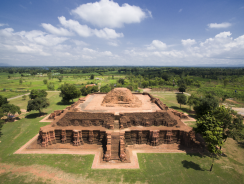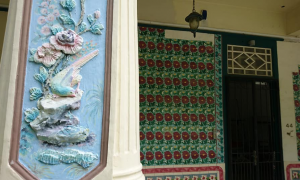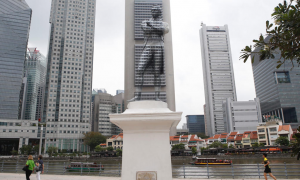The persecution of minority groups.
The celebration of ancient heritage.
Muslim communities driven from Rakhine state and forced to seek refuge in neighbouring Bangladesh.
Buddhism’s sacred landscapes and living traditions recognised by the international community.
Human rights and heritage – two issues that appear so unrelated as to be irreconcilable. In the face of human suffering, heritage can feel like… an indulgence. How can we think about visiting historic monuments when hundreds of thousands of people have been displaced? Why protect and preserve old temples when homes and places of worship are being deliberately burnt down? Why worry about the effect of natural disasters on heritage sites when manmade disasters enacted upon real people are equally destructive and – theoretically anyway – more easily avoided?

Tourists at Bagan. Image credit: Natali Pearson, 2019.
The usual response to such questions is that access to and enjoyment of cultural heritage is a human right, one that is guaranteed by international human rights law, including the Universal Declaration of Human Rights, and protected from destruction during times of conflict through international instruments like the 1954 Hague Convention. So central is heritage to human rights discourses that scholars have used the term ‘cultural genocide’ to describe the intentional vandalism of heritage sites. Such destruction has been framed as part of ‘a systematic attempt to scrub away the identity, history and memory of entire peoples’. Not only can heritage tell us who we are and who we were, but the ways in which we manage it – whose stories we choose to tell, and whose are elided – also tell us about who we want to be.
This approach, in which heritage is a human right, is a valid response. Heritage – including intangible and underwater heritage – does have a place in the discussion of priorities and resources, even in countries that are dealing with past or ongoing human rights abuses.
In fact, these discussions are even more important in such countries. Rather than limiting ourselves to the idea of heritage as a human right, I am increasingly interested in using human rights as a productive methodology for thinking about heritage. This is because the different ways a state manages human rights issues and heritage issues can tell us about how that state understands diversity and identity, and about the effectiveness of international engagement in achieving desired outcomes. Cultural tourism of heritage sites can also improve livelihoods when undertaken judiciously.
There is no better place to bring these issues into conversation with each other than Myanmar, where the Government has been grappling with the transition from military to civilian rule for the past decade. In the past year alone, the Government has been accused of genocide on a massive scale at the same time as it has been recognised on the world stage for the ancient and sacred landscape of Bagan.
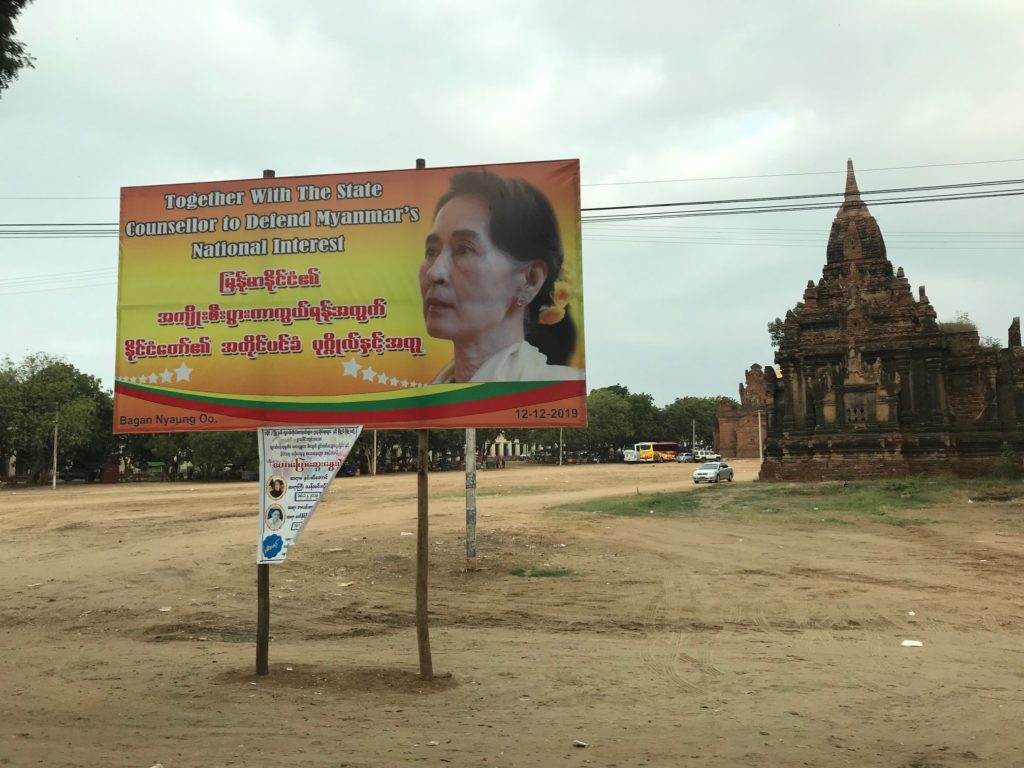
Roadside signs in Bagan in support of State Counsellor Aung San Suu Kyi. Image credit: Natali Pearson, 2019.
Just last month, State Counsellor Aung San Suu Kyi appeared at the International Court of Justice in The Hague to defend Myanmar’s human rights record amidst allegations of genocide against its Rohingya minority in 2017. In what Amnesty International has described as the biggest human rights catastrophe in the region, up to 1 million people are believed to have been affected by ‘cleansing’ operations undertaken by military and security forces in 2017. A report delivered by the International Independent Fact-Finding Mission in Myanmar in September 2019 drew attention to the situation of ethnic minorities in not only Rakhine but also Chin, Kachin and Shan States, all of whom ‘have suffered human rights violations and violations of international humanitarian law at the hands of the Tatmadaw [armed forces of Myanmar].’ The Report’s authors noted with regret the failure of Myanmar to engage or respond to communications.
Sitting in contrast to this reluctance to engage were the celebrations in Naypyitaw that accompanied the inscription of the ancient city of Bagan on the UNESCO World Heritage list in July 2019, in the process becoming Myanmar’s second World Heritage property (the other being the Pyu Ancient Cities, recognised in 2014). The inscription recognises the significance of Bagan’s landscape, material evidence and continuing religious and cultural practices, which together create a site of ‘outstanding universal value’.
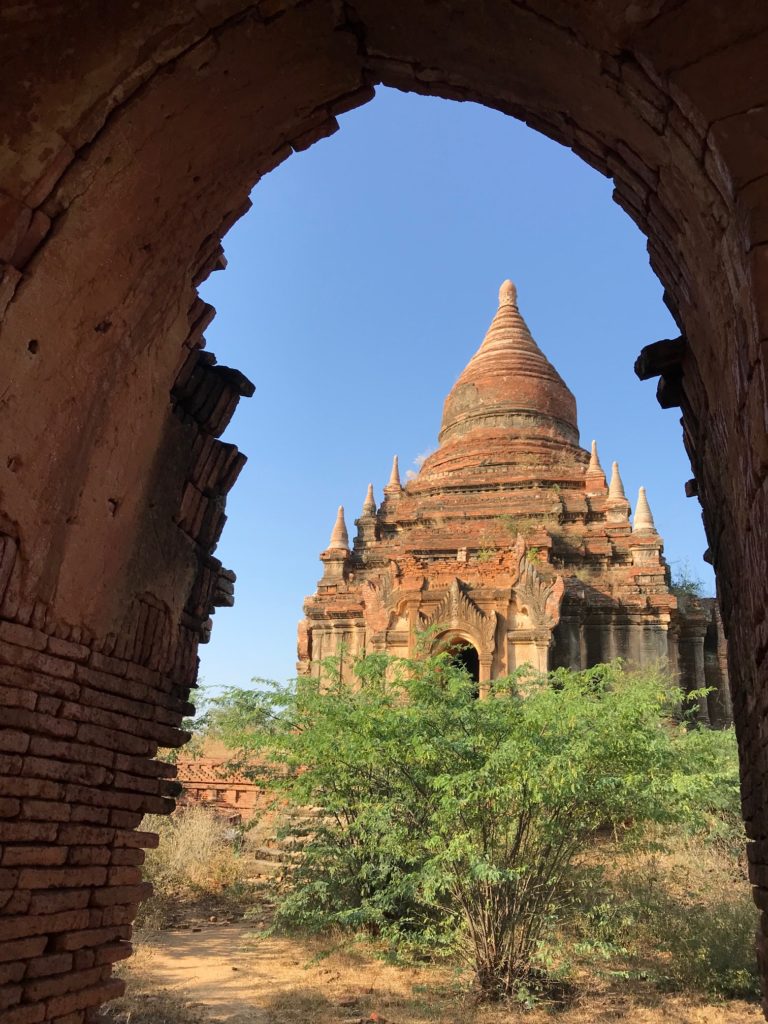
One of Bagan’s thousands of temples, stupas and pagodas. Image credit: Natali Pearson, 2019.
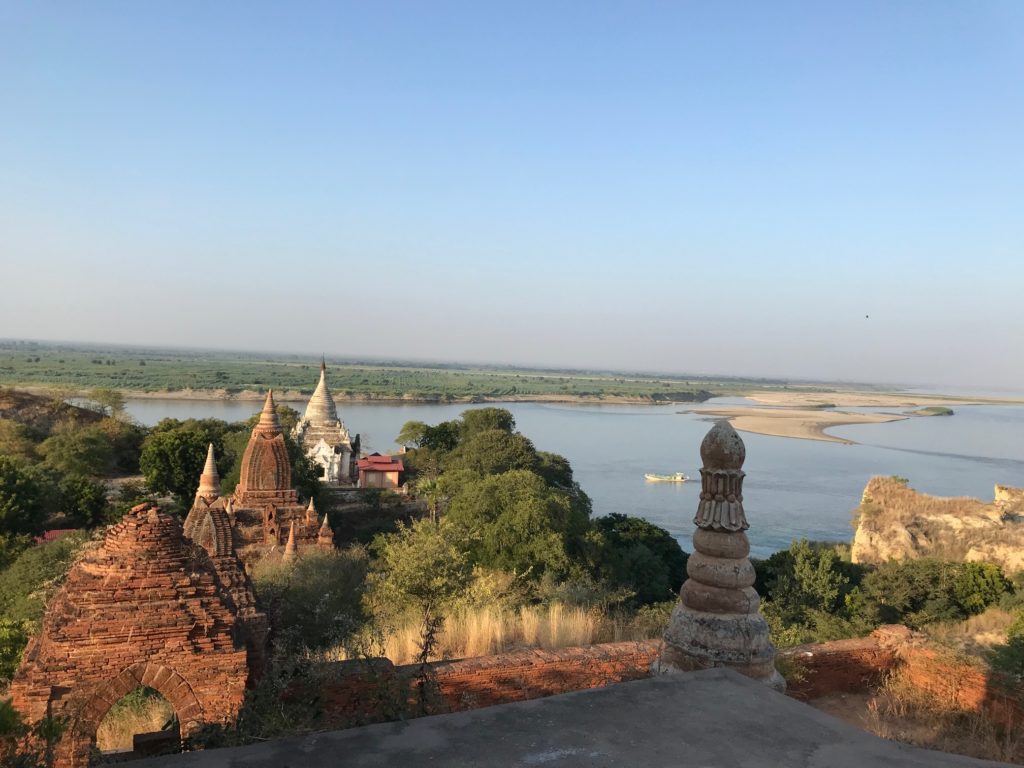
Temples overlooking the Irrawaddy river in Bagan. Image credit: Natali Pearson, 2019.
At stake here is nothing less than the question of Burmese identity. This is exemplified by Aung San Suu Kyi’s framing of Bagan as a ‘hub of diversity of cultures, people and ideologies of the world’.She also highlighted the role of heritage in bringing people closer together and generating mutual respect. These remarks pay lip service to diversity but are at odds with the human rights violations experienced by many of Myanmar’s ethnic minorities. They also gloss over the way in which Bagan has been used as a powerful symbol of a deep historical and ethnically-based nationalism. What remains unclear, therefore, is how Bagan’s ‘outstanding universal value’ at the macro-level can accommodate diversity at the micro-level. Indeed, some scholars have drawn attention to how such universal valuations are ‘a means by which local stakeholders and communities with a particular interest in heritage places can be excluded from having a role in making decisions about managing them’ (Rodney Harrison, Heritage: Critical Approaches, p. 110).
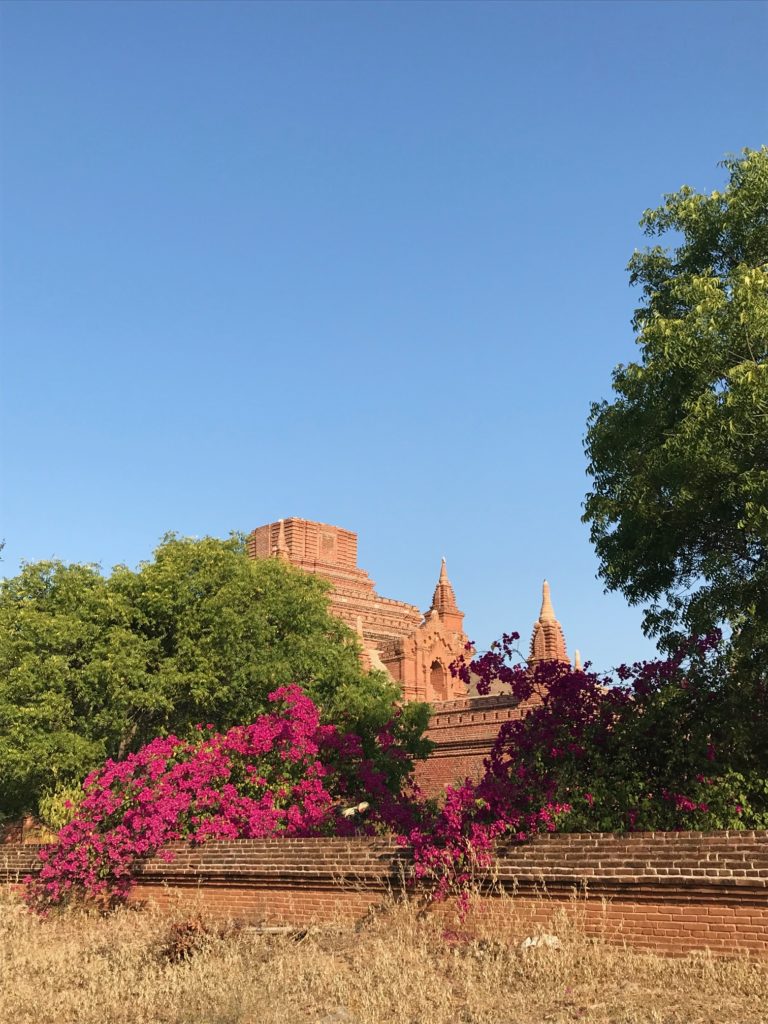
A temple in Bagan that is cared for by local villagers. Image credit: Natali Pearson, 2019.
In Myanmar, issues of diversity and inclusion have been ‘at the heart of Burmese politics since the start of modern Burmese politics a hundred years ago’, resulting in ‘an identity crisis that has not yet been resolved’ (Thant Myint-U, The Hidden History of Burma, p. 256). Hence the UNESCO inscription of Bagan, a Buddhist site in a majority Buddhist country, is used by Myanmar’s leaders to demonstrate diversity at the same time as it reaffirms the centrality of a certain type of (religious, racial and cultural) identity within the national narrative. In embracing the opportunities presented by the world heritage inscription, we must move past these prevailing narratives and towards a new imagining of Myanmar as a country that is profoundly multiracial and multicultural, in which ‘race, ethnicity, and identity [are] mutable, evolving and contingent’ (Thant Myint-U, The Hidden History of Burma, p. 188).
Will oil hunters destroy Thailand’s biggest ancient city?
A proposal to build oil drilling rigs 100 metres from an archaeological site near Si Thep Historical Park jeopardises what may be Thailand's oldest and biggest ancient city.
The juxtaposition of human rights and heritage in the context of Myanmar can also tell us about the efficacy of isolation versus engagement in global relations. The inscription of Bagan suggests that carrots work better than sticks. From Myanmar’s perspective, the inscription is affirmation that the international community remains willing to engage despite decades of self-imposed isolation, external sanctions and a deteriorating human rights situation. Furthermore, the inscription is indicative of Myanmar’s ability to respond to international expectations. Myanmar began the Bagan nomination process in 1994-5, but it was not progressed by UNESCO due to a lack of appropriate heritage legislation and reservations about Myanmar’s ability to manage the site in accordance with international heritage standards. UNESCO is now sufficiently convinced that such concerns have been addressed, although evidence of earlier mismanagement can be seen to this day in the water-hungry golf course, unerringly straight road laid across archaeologically-rich areas and many tourist hotels that populate the templed landscape, including in the Bagan Archaeological Zone.
The takeaway message here is that Myanmar is willing and able to respond to international pressure in the field of heritage governance and protection. We must continue to hope that positive engagement in relation to human rights remains a possibility.
Finally, bringing human rights into conversation with heritage can help us think beyond the knee-jerk travel boycotts that are already beginning to affect local communities and tour operators in Myanmar. When the inscription was announced, President U Win Myi expressed high expectations that ‘Arrival of tourists to the Bagan region would surely increase, helping the economic development of the local people’. But instead of seeing an increase in visitors as is often the case following a World Heritage listing, tourist numbers have dropped. Anecdotal evidence suggests that local tour operators in Yangon and Bagan have declined by up to 70% in the past twelve months, affecting what was a burgeoning tourist economy. For many would-be visitors, it has been difficult to reconcile visiting heritage sites in a country where significant human rights abuses are occurring.
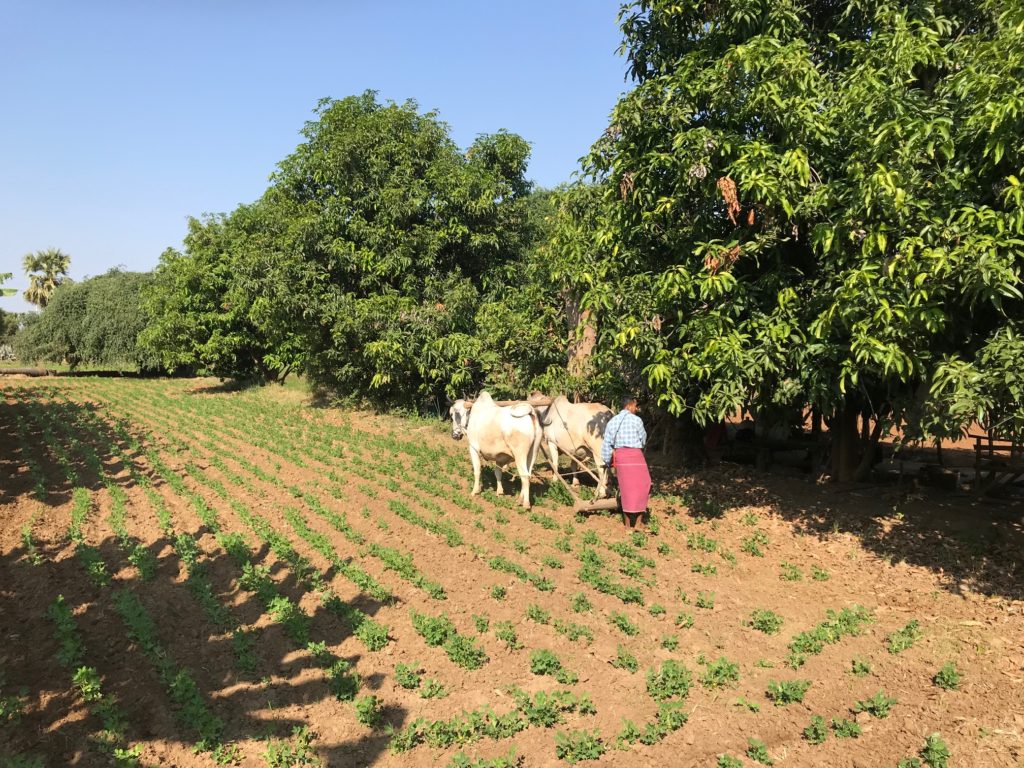
A farmer at Mi Ta Zu permaculture farm in Bagan. The farm is supported by local non-profit organisation Myanmar Seeds. Image credit: Natali Pearson, 2019.
But now is not the time for tourists to boycott Myanmar. Instead, visitors should visit Myanmar’s acclaimed heritage sites, and should foreground human rights as they do so. This creates the opportunity to learn: about the dominance of Buddhism in the national narrative, about Myanmar’s complex histories, about the racial, linguistic and religious diversity of this country, and about its competing internal nationalisms. And about the ways that ethical and sustainable tourism can benefit those who rely on such income for their livelihoods, for better health outcomes, and for their education. In this way, the message of Bagan’s preservation sits not in juxtaposition to, but alongside, the destruction that is taking place in other parts of the country.
Note: I am grateful to participants of the Sydney Southeast Asia Centre’s Workshop on Human Rights (September 2019) and to the Master of Human Rights students who presented at the Land of a Thousand Pagodas event (October 2019) for encouraging me to integrate human rights more deeply into my research and teaching practices.
Join the conversation on Facebook!
 Facebook
Facebook  Twitter
Twitter  Soundcloud
Soundcloud  Youtube
Youtube  Rss
Rss 
